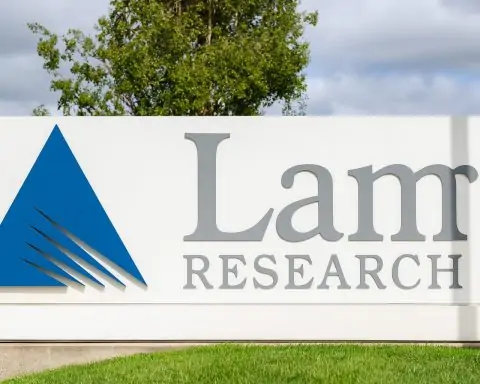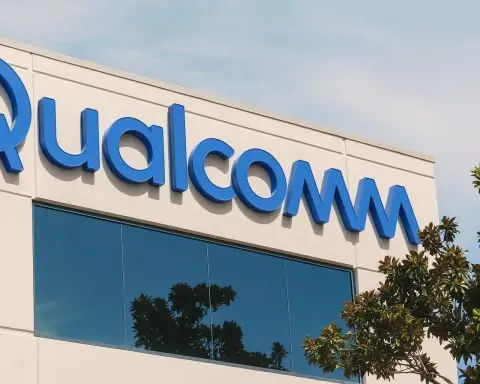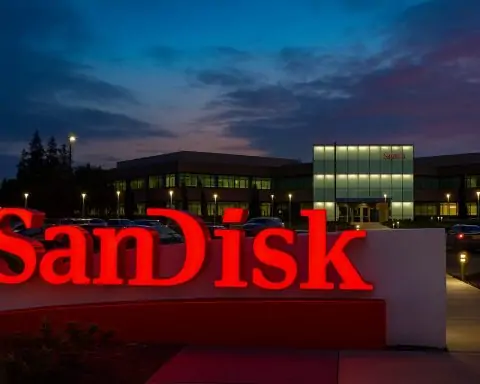- Surging stock on AI milestone: New Era Energy & Digital (NASDAQ: NUAI) shares spiked nearly 80–90% in a single day on Oct. 9, 2025 after news of progress on its flagship AI data center project, marking it among the market’s top gainers [1]. This follows a similar +50% surge on Sept. 25 when Phase One of the project was completed [2].
- Flagship project – 1GW AI data center campus: NUAI’s 50/50 joint venture Texas Critical Data Centers (TCDC) with Sharon AI is developing a massive 1-gigawatt AI-optimized data center campus in West Texas. The project just entered Phase Two engineering (site clearing, detailed planning) after clearing Phase One feasibility milestones [3] [4]. The site spans 438 acres with an on-site power station planned, aiming for initial power delivery by early 2027 [5] [6].
- Strategic pivot from helium to AI: Formerly New Era Helium, Inc., the company rebranded in August 2025 to reflect its shift into powering digital infrastructure [7] [8]. NUAI still holds natural gas and helium assets but is now focused on “vertically integrated” energy + data center solutions for the AI boom [9] [10]. Key partnerships were inked for power and connectivity, including a 250 MW power agreement with Thunderhead Energy and a 1,600-mile fiber network MOU with GlobeLink to support the Texas campus [11] [12].
- Financial boosts and challenges: NUAI raised about $13.8 million via equity sales and converted ~$6.1 million of debt to equity in recent months [13]. It also repaid the remaining ~$2.6 million of senior notes on Oct. 1, 2025 [14]. These moves improved its balance sheet (cash was ~$5.2M mid-year) and helped meet Nasdaq’s shareholder equity requirement [15]. However, fundamentals remain weak – Q2 2025 revenue was only ~$0.53M against a $3.6M net loss, and the stock was trading at an astronomical ~91× sales with deeply negative margins [16] [17].
- Nasdaq compliance at stake: NUAI fell below Nasdaq’s $50M market-cap listing threshold earlier in 2025. It received a delisting notice and has an appeal hearing on October 16, 2025 to remain listed [18]. The company believes its recent actions (debt retirement, cash infusion) improved its finances [19], and the Oct. 9 price jump briefly lifted its market cap above $75M [20] – potentially easing the compliance issue – but the outcome of the hearing (and sustained valuation) remains a key uncertainty.
- Volatile micro-cap with promotion-fueled rallies: NUAI’s 52-week range is $0.32 to $2.98 [21], underscoring extreme volatility. The stock hit an all-time high around $12 in late 2024 before crashing to all-time lows in September 2025 [22]. The company has actively courted investors through paid media – funding a TV ad campaign from Sept. 11–Oct. 8 and another starting Oct. 9 [23] – which, along with AI hype, has driven massive trading volume. Market sentiment is speculative: NUAI trades more on momentum than fundamentals, and one analysis noted its chart “has behaved like a trading vehicle” for fast-moving traders [24].
Latest Developments & October Stock Surge
After a quiet summer, New Era Energy & Digital’s stock exploded in early October 2025 on the back of major project news and aggressive investor outreach. On October 9, NUAI shares nearly doubled intraday – a one-day jump of roughly 80% – following fresh updates on its West Texas data center venture [25]. The rally took the stock from around $1.54 to roughly $2.8–$2.9, on extraordinarily heavy volume. This kind of move echoed the late-September spike when NUAI announced completion of Phase One engineering; at that time, the stock closed +49.8% in a single session (Sept. 25) as retail traders piled in on the AI infrastructure storyline [26].
What sparked the Oct. 9 rally? On October 6, New Era issued a press release (and an 8-K filing) announcing it had commenced Phase Two engineering for its flagship Texas Critical Data Centers project [27]. By Oct. 8, a sponsored Proactive Investors interview with CEO Will Gray further highlighted the milestone, spreading the news that “the company has commenced Phase Two engineering for its Texas Critical Data Centers (TCDC) project — the company’s flagship data center and power development initiative in West Texas” [28]. In Phase Two, the JV will undertake detailed site planning, initiate site clearing within 60 days, and integrate infrastructure – a significant step toward actual construction [29]. This concrete progress on a 1GW-scale AI data campus appears to have rekindled investor excitement. By the morning of Oct. 9, NUAI was featured on “top gainer” screens, and momentum built throughout the day, supercharged by speculative enthusiasm.
It’s worth noting that NUAI’s sudden leaps have coincided with active promotional campaigns. The company is availing itself of investor relations services to boost visibility: it paid RedChip Companies $112,500 for a national TV ad campaign from Sept. 11 to Oct. 8, 2025, and another $250,000 for ads running Oct. 9 to Nov. 5, 2025 [30]. These paid awareness campaigns mean NUAI’s story (and press releases about its AI data center plans) have been broadcast to retail investor audiences across financial media. The immediate result has been heightened trading interest – for example, NUAI’s trading volume on Sept. 25 hit 76.6 million shares as the stock jumped, and pre-market quotes the next day were already 35% higher [31] [32]. A similar dynamic likely played out around Oct. 9, with the new Phase Two news amplified by marketing efforts.
Market observers urge caution amid the frenzy. While the price action shows traders eagerly reacting to NUAI’s AI ambitions, there was no sudden change in the company’s fundamentals overnight. The Phase Two engineering news, though positive, signifies that the project is moving ahead on schedule rather than a new revenue source. Seasoned analysts note that such micro-cap rallies can be short-lived unless followed by concrete business execution. In NUAI’s case, the stock gave back some gains after the Sept. 25 spike, illustrating the volatility. The extreme intraday swings (e.g. a fall of ~7.8% on Oct. 8 before the big jump on Oct. 9) [33] underline how speculative the trading has been. Traders on forums have both hyped NUAI as a play on the “hottest sector” (AI infrastructure) and warned that its thin float and paid promotion make it a risky bet. In short, the recent stock surge reflects a potent mix of real news (advancement of the data center project) and market momentum – a combination that can produce dramatic short-term results but also demands careful scrutiny.
AI Data Center Vision and Business Strategy
New Era Energy & Digital’s entire investment thesis now hinges on its flagship AI data center initiative in the Permian Basin. This project, Texas Critical Data Centers (TCDC), represents a bold pivot from the company’s origins in helium extraction toward becoming a provider of energy-enabled digital infrastructure. Here’s an overview of what NUAI is building and why it has attracted attention:
- A 1-Gigawatt AI Campus: The TCDC project aims to develop a campus ultimately scalable to 1 GW of power capacity, dedicated to high-density AI and high-performance computing workloads [34]. If achieved, this would make it one of the larger AI data center complexes in North America. The campus footprint will cover 438 contiguous acres (the JV is in the process of acquiring an additional 203 acres to reach that size) [35], providing room for long-term expansion. Such scale is intended to meet surging demand for GPU-based computing – “AI infrastructure growth [is] expected to accelerate exponentially over the next decade,”the company notes [36]. By combining massive “behind-the-meter” power generation on-site with data center construction, New Era aims to offer hyperscale and cloud operators a vertically integrated solution (power + real estate + compute infrastructure) that lowers costs and speeds deployment [37].
- Joint Venture with Sharon AI: NUAI is not going it alone. The project is a 50/50 joint venture with Sharon AI, Inc., a partner focused on AI technology. Together they formed Texas Critical Data Centers LLC in 2024 [38]. Sharon AI’s involvement presumably brings domain expertise or potential end-users in AI, while New Era brings energy infrastructure know-how and site resources. This partnership structure also means New Era would share both the costs and the eventual benefits of the data center campus. The JV model mirrors moves by other energy-and-data collaborations – leveraging one partner’s power assets with another’s tech clientele.
- Phase One Done; Phase Two Underway: By late September 2025, TCDC completed Phase One engineering, which encompassed environmental studies (all passed), initial data center feasibility assessments, and electrical load studies [39]. These results “validate the constructability of the project and the pathway for intended power delivery beginning in early 2027,” according to the company [40]. CEO E. Will Gray II celebrated the milestone, saying “We are de-risking one of the most ambitious AI data center site developments in the United States. Completion of Phase One engineering validates both the strength of our project and the discipline of our development approach.” [41] With Phase One de-risking done, Phase Two engineering has now commenced (announced Oct. 6). Phase Two focuses on the practical build-out preparations: detailed site planning, initiating site clearing within 60 days, and integrating the power infrastructure into the data center design [42]. TCDC is already soliciting bids for site clearing contractors, with ground-breaking expected to begin in the next two months [43]. Achieving this Phase Two kickoff on schedule was clearly a major goal for 2025, and it signifies that NUAI’s vision is moving from paper to dirt – i.e. actual site work.
- Fast-Track Permitting & Location Advantages: One strategic advantage NUAI touts is the location of the site in an “air-quality attainment” zone in West Texas [44]. This is important for regulatory reasons: the company can pursue a “minor source” air emissions permit (allowing up to 250 tons of emissions per year) which can be approved in roughly 90 days, versus a potential 18-month process for a major-source permit in more polluted areas [45]. In other words, building in a region with cleaner air gives a faster path through environmental permitting for backup generators or on-site power plants. Additionally, being in the Permian Basin provides proximity to abundant natural gas and energy resources, which is ideal for an integrated power-and-compute project [46]. The site is also positioned along a developing “AI corridor” in Texas, and the plan includes direct fiber connectivity – a must for modern data centers. In September, the JV signed a 1,600-mile fiber network MOU with GlobeLink to establish high-capacity, sub-5ms latency fiber routes across Texas [47]. This would connect the remote campus to major network hubs, ensuring low-latency links for AI workloads. In short, TCDC’s location was chosen to optimize energy and network access while minimizing red tape.
- Power: Behind-the-Meter Energy Islands – The crux of New Era’s strategy is power supply independence. Rather than rely solely on the grid, TCDC intends to build on-site power generation (“power islands”) to directly feed the data center’s enormous electricity needs. This addresses a new Texas law (Senate Bill 6) that requires large industrial loads like data centers to have their own backup power so as not to strain the ERCOT grid [48]. Over the summer, the JV announced several steps to secure power: In July 2025, TCDC and Thunderhead Energy Solutions signed a strategic agreement to develop a dedicated 250 MW power stationfor the campus [49]. This would likely be a natural gas-fueled plant (given Permian gas is plentiful) situated adjacent to the data center. Additionally, on Sept. 10 the company inked an LOI with Mawgan Capital for a proprietary “Digital Zero Power™” solution – essentially a behind-the-meter clean power system for the Ector County site [50]. These agreements are mostly at the memorandum stage (non-binding until converted to definitive contracts) [51], but they outline a blueprint where NUAI controls its energy supply. The goal is to begin construction of the on-site power infrastructure in 2026 in tandem with the first data center buildings [52]. If executed, this vertically integrated model (owning power generation plus the data halls) could make the campus more resilient and cost-efficient for future tenants. By 2027, the JV targets initial power-up and capacity availability on campus, with further expansion planned as demand grows [53].
- Customers and Use-Cases: Although New Era has not announced any anchor tenants yet, the target market is clear – hyperscalers, AI startups, cloud providers, and enterprise HPC users looking for large-scale, energy-efficient infrastructure. The company’s messaging highlights providing “turnkey solutions” (ready-to-go powered shells) that enable big operators to “accelerate data center deployment” and “future-proof their infrastructure investments” [54]. In practice, NUAI would likely lease out powered space or partner with cloud/AI firms to build to suit. The emphasis on liquid-cooled, high-density computing suggests they anticipate hosting AI training clusters (which generate lots of heat and typically use water or advanced cooling). It’s also notable that NUAI’s legacy helium business could tie in here: Helium is a critical component for semiconductor manufacturing and certain cooling systems. The company has hinted that it sees a role for its helium assets in the AI ecosystem(for instance, supplying the chip fabs that make GPUs) [55]. For now, though, helium production is on the back burner – their planned helium plant in New Mexico (Pecos Slope) has been delayed, and a major offtake contract with Matheson Tri-Gas was canceled after the plant missed its startup deadline [56]. New Era says it is “in discussions with various parties” to maximize value from its natural gas and helium holdings, potentially via sale or joint development [57]. The big picture: NUAI is reinventing itself as an enabler of AI computing, leveraging its energy background. The TCDC project is the embodiment of that strategy – essentially an “energy meets AI” play, where owning the energy source is as important as the data center itself in serving next-gen computing needs.
This ambitious vision puts New Era Energy & Digital at the intersection of two booming sectors – energy infrastructure and artificial intelligence. If the company can actually deliver even a portion of the 1GW campus and attract major AI tenants, it could transform NUAI’s financial profile in the future. However, as we discuss next, the financial and execution challenges are non-trivial, and NUAI will need significant capital and operational prowess to turn this vision into reality.
Financial Health Check: Cash, Losses and Nasdaq Listing Concerns
While the AI data center plan is forward-looking, NUAI’s current financials reflect a company still in a developmental, cash-burning stage. Investors should carefully weigh the company’s balance sheet strength (or lack thereof) and ongoing dilution against its growth plans.
Recent Earnings and Losses: New Era Energy & Digital’s latest reported quarter (Q2 2025) showed minimal revenue and substantial losses. The company generated only about $532.8 K in revenue for that quarter, yet had a net loss of roughly $3.61 million [58]. In other words, NUAI’s operations are pre-revenue relative to the scale of its expenses – likely because its helium projects have not come online and the data center project is not yet producing any income. The net loss also widened dramatically from the prior year (Q2 2024), indicating higher spending as the firm pursues its new strategy [59]. On a per-share basis, Q2 came in at a –$0.21 loss, worse than the –$0.18 a year earlier [60]. Notably, there was a “surge in revenue” (perhaps from helium test sales) compared to near-zero sales before, but it’s still very small in absolute terms [61]. The bottom line is that NUAI remains deeply unprofitable and will be for the foreseeable future while it builds out its infrastructure projects.
Liquidity and Cash Burn: As of June 30, 2025, NUAI’s balance sheet showed current assets of $8.26M (including about $5.2M cash), against current liabilities that were likely several million (exact figures not given in sources) [62]. The company’s operating cash flow was –$1.85M for the first half, reflecting ongoing cash burn [63]. In fact, most of the cash inflows in recent periods have come not from business operations but from financing activities – namely, issuing new shares [64]. This is common for pre-revenue companies, but it means NUAI’s runway depends on access to investor capital.
Dilution and Capital Raises: In the second half of 2025, New Era undertook significant capital raising to bolster its finances:
- Since June 30, the company issued 17,266,344 new shares of common stock for $13,813,206 in gross proceedsunder an equity purchase agreement (essentially an at-the-market offering facility) [65]. This injection of ~$13.8M in cash was critical to fund operations and the initial development work on TCDC. However, issuing ~17.3 million shares is substantial dilution – by comparison, NUAI had only around 18 million shares outstanding at the start of 2025 (estimated). The equity issuance roughly doubled the share count, meaning existing shareholders’ stakes were significantly diluted in percentage terms.
- In addition, NUAI addressed its debt load. As of mid-2025, the company had about $8.76M in senior secured convertible notes outstanding [66]. During Q3, holders of $6.12M of those notes converted their debt into 6,125,000 shares of stock [67] (a conversion price of roughly $1.00 per share, indicating noteholders became equity owners at a relatively low price). The remaining ~$2.64M balance of the notes was repaid in cash on Oct. 1, 2025, and the lien on the company’s assets was released [68]. Clearing this debt is a positive development – it eliminates interest expense and removes the overhang of secured creditors – but again it came at the cost of more share issuance and use of a chunk of the new cash.
After these moves, New Era stated that it believes it now satisfies Nasdaq’s stockholders’ equity requirement for continued listing [69]. Nasdaq listing rules for the Global Market typically require at least $10M in stockholders’ equity. By converting debt into equity and raising new cash, NUAI likely improved its equity (assets minus liabilities) into positive territory. However, another Nasdaq rule – the Market Value of Listed Securities (MVLS) – has been a thornier issue. As mentioned, in March 2025 NUAI was notified by Nasdaq for falling below the $50M market cap minimum for over 30 days [70]. The company had until Sept. 2 to regain compliance, which it did not, so on Sept. 3 it received a determination letter that it would be delisted absent an appeal [71]. NUAI has requested a hearing scheduled for Oct. 16, 2025, which stays any delisting action pending the outcome [72]. At the hearing, NUAI’s management will presumably present their case – possibly highlighting the recent capital raises, reduction in debt, and the stock’s recovery well above $1 per share – to argue that they can maintain compliance going forward. It’s worth noting that thanks to the October price spike, NUAI’s market cap jumped to ~$75M (at ~$2.64/share as of Oct. 9) [73], which is comfortably above $50M. The challenge will be keeping it above that threshold for the required period. If the stock were to sag again or if Nasdaq isn’t convinced of the sustainability of NUAI’s valuation, there’s a risk the stock could eventually be delisted or down-listed to a lower exchange. Such an event would hurt liquidity for investors.
To ensure longer-term financing, NUAI has expanded its ability to sell shares if needed. In an update, the company noted it amended its equity purchase agreement with an institutional investor to allow up to $75 million in common stock sales going forward [74]. This essentially gives NUAI a sizable war chest on paper – they can tap this equity line over time to raise cash, assuming trading volumes and prices remain favorable. However, raising anywhere near $75M via equity would mean massive additional dilution (for perspective, $75M is about the entire current market cap of the company). It’s a double-edged sword: the facility provides flexibility to fund the project’s next phases, but each draw will increase the share count and could put downward pressure on the stock price if not matched by tangible progress.
Quality of earnings and ratios: Given the tiny revenue base and large losses, most traditional valuation metrics paint a stark picture. For instance, NUAI’s price-to-sales (P/S) ratio was recently over 90× [75] – an extremely high number indicating that investors are valuing the company at ~90 times its annual sales. This is typical only for early-stage or speculative companies; it underscores that NUAI’s valuation is based on future potential rather than current fundamentals. Profitability metrics are deeply in the red: the company’s pretax profit margin was about –1517% in the last report [76], and return on assets (ROA) stands around –37% [77]. These figures simply reflect that New Era is losing money on every dollar of assets and sales right now. Even the book value isn’t reliable – due to accumulated losses, NUAI’s tangible book value per share is negative, meaning liabilities exceeded tangible assets before the recent capital raise [78]. The recent infusion of cash will improve the balance sheet somewhat, but the company will almost certainly continue to run at a loss (and thus likely at a negative operating cash flow) until it either brings the helium plant online or, more transformatively, gets an AI data center online with paying customers.
In summary, NUAI’s financial health is improved but still fragile. The company has removed the immediate threat of debt default by clearing its secured notes [79], and it has some cash to work with now, but it remains heavily reliant on external funding. The strategy of “raise cash, spend on development, raise more cash if the stock goes up” can work as long as investors maintain confidence. Any major setbacks in project execution or a downturn in market sentiment could cut off the funding pipeline. Thus, current and prospective shareholders should keep a close eye on the Nasdaq hearing (to ensure the stock remains listed) and on the company’s cash burn rate versus its ability to raise capital. NUAI’s finances reflect a typical pre-revenue startup: high risk, high potential reward if the plan succeeds, but with a limited margin for error in the meantime.
Market Performance and Sentiment
New Era Energy & Digital’s stock has become a rollercoaster ride in 2025, heavily influenced by news flow and market sentiment around AI. Understanding how the market views NUAI requires looking at its wild price swings and the context behind them:
- Volatility is the norm: NUAI has traded as low as $0.32 and as high as $2.98 in the past 52 weeks [80] – a range of over 800%. In fact, from an all-time high of ~$12.29 in Dec 2024 down to ~$0.32 in early Sept 2025, and then back above $2 by October, the stock has see-sawed dramatically [81]. This kind of volatility is usually seen in micro-cap stocks that capture speculative interest. A contributing factor is NUAI’s share float (the number of shares publicly available) which, while larger now after recent issuances, is still relatively small and can be prone to quick spikes on increased demand. Traders have capitalized on this, treating NUAI as a momentum play when news hits. As one analyst noted, “From an ATH ~$12.29 to an ATL ~$0.32 and back to $1+, NUAI’s tape has behaved like a trading vehicle”, so prudent position sizing and risk management are crucial [82].
- AI hype and retail attention: The broader context of 2023–2025 is a massive hype cycle around anything “AI.” NUAI’s pivot into AI data centers came at a fortuitous time, as investors have been scouring for “ picks and shovels” plays to ride the AI wave. This has put NUAI on the radar of retail traders, especially after its explosive moves. Financial news outlets have occasionally highlighted NUAI on lists of “soaring penny stocks” alongside other AI-themed small caps [83]. For example, a late September 24/7 Wall St. article cited New Era Energy & Digital and Datavault AI as “AI penny stock powerhouses” that were surging, while cautioning about the inherent risks [84]. Similarly, Benzinga’s daily top movers page flagged NUAI’s big gain on Sept. 25, which helped draw in momentum players [85]. On social media and forums like Reddit’s r/pennystocks, users have been actively discussing NUAI – some posts enthusiastically tout the company’s “pivot into the hottest sector on earth” (AI infrastructure) and its “1GW AI campus” as reasons the stock could continue to rise [86]. This retail enthusiasm can feed on itself; once NUAI starts moving up, day traders and algorithmic traders pile in, amplifying the swings.
- Promotional activity: As mentioned, NUAI’s management has not been shy about promoting their story. The RedChip TV campaigns and sponsored content (like the Proactive interview) indicate that the company is proactively trying to build its shareholder base. These efforts can certainly boost short-term interest. However, seasoned investors often view paid promotion with caution – it raises questions about whether a stock’s rise is driven by genuine fundamentals or by marketing. NUAI’s case seems to be a bit of both: there is a real project with measurable milestones being hit, but the magnitude of the stock’s moves suggests a heavy dose of trading hype. It’s telling that the company itself explicitly disclosed the details of its investor awareness campaigns (as required by law): it spent nearly $362,500 on TV ads spanning September to early November [87]. Such campaigns are not inherently bad – many small-caps use them to get on investors’ radar – but they do mean one should take any overly bullish coverage with a grain of salt. For instance, RedChip’s own profile on NUAI highlights the fiber MOU and power partnerships in glowing terms [88], but also clearly states that RedChip was paid by the company for visibility [89].
- No institutional analyst coverage: NUAI currently has little to no coverage from Wall Street analysts, which is typical for a company of its size (market cap in the tens of millions). Zacks Investment Research shows no analyst price targets or earnings estimates on file for NUAI [90]. The absence of traditional coverage means there are no consensus forecasts or ratings to guide investors – sentiment is being set mostly by the company’s press releases, plus independent commentary from small-cap blogs and investors themselves. Some AI-based stock forecast sites have issued technical ratings (one algorithm recently rated NUAI a “Strong Buy” based on momentum indicators [91]) or short-term price predictions (another forecast expects the stock to hover around $1.50–1.60 in the next month, essentially flat [92]). But these are highly speculative. The real “analysts” for NUAI at this stage are the investors on the ground, reacting to news and trading the stock.
- Market sentiment: cautious optimism vs. skepticism. How do market observers view NUAI’s long-term prospects? It’s a mixed bag. On one hand, optimists point to the enormous demand for AI infrastructure – quoting OpenAI’s CEO Sam Altman: “AI can only fulfill its promise if we build the compute to power it.” [93]From that perspective, any company securing energy and land for data centers in 2025 is positioning for a multi-year wave of growth. NUAI’s team has repeatedly stressed that they are ahead of the curve in planning for AI’s exponential growth, and some investors are buying into that vision. On the other hand, skeptics highlight the gap between NUAI and its much larger peers. A TechSpace analysis bluntly noted that NUAI is a micro-cap (tens of millions in value) trying to play in a space where multi-billion-dollar decisions set the pace [94] [95]. In other words, the “gigawatts war” in AI data centers is being fought by giants with huge capital – think of cloud titans or specialized firms backed by billions. For instance, Applied Digital (NASDAQ: APLD), a somewhat comparable company that pivoted from crypto mining to AI data centers, saw its stock soar earlier in 2023, giving it a market cap in the hundreds of millions; yet even APLD has been cautioned by analysts as potentially “priced for perfection” with a lot to prove [96]. NUAI, being far smaller and earlier-stage, faces even more skepticism. Many market participants see NUAI as an exciting story but a speculative bet – suitable perhaps for a small allocation in a portfolio, but not something to “bet the farm” on given the volatility and execution risk. The StocksToTrade blog, which has covered NUAI’s moves, echoed this sentiment by dissecting the financial red flags (huge losses, high P/S ratio) and advising traders that while the stock’s momentum is noteworthy, “until [financial metrics improve], potential investors are advised to tread carefully… mindful of penny stock volatility.” [97]
In sum, market sentiment on NUAI oscillates between hopeful and wary. The hopeful camp focuses on the transformative potential of building a major AI data hub (with some viewing NUAI as a miniature version of an AI infrastructure REIT or a future acquisition target if it proves out its site). The wary camp focuses on the dilution, the promotional aspect, and the fact that NUAI’s current valuation (even after the run-up) still implies significant future success just to justify it. This dynamic sets up a classic high-risk/high-reward scenario in the stock.
Competition and Industry Landscape
New Era Energy & Digital isn’t operating in a vacuum – it’s part of a broader trend of companies racing to build infrastructure for the AI computing boom. To evaluate NUAI’s prospects, it’s instructive to compare it to some peers and industry benchmarks, and to understand the competitive pressures and opportunities in this niche.
- Peers in “energy-to-AI” data centers: Interestingly, NUAI is not the only player pivoting from energy or crypto into AI data centers:
- Applied Digital (NASDAQ: APLD): Perhaps the closest analog, APLD operates data centers (initially for crypto mining) and has been reorienting them for AI and HPC workloads. APLD’s stock climbed several hundred percent in 2023 as it announced AI hosting deals, giving it a market cap well above $500M at one point. However, some analysts have urged caution on APLD, saying the stock may be “priced for perfection” as it awaits bringing new capacity online [98]. This highlights a point for NUAI: excitement can run far ahead of reality, and when a company is valued on future AI capacity, any delay or under-utilization of that capacity can hit the stock hard.
- CoreWeave & Core Scientific: In a headline-grabbing deal mid-2025, CoreWeave – a fast-growing AI cloud provider – agreed to acquire Core Scientific (NASDAQ: CORZ), a large Bitcoin miner that went bankrupt, for ~$9 billion in stock [99]. The rationale was to secure Core Scientific’s 1.3 GW of power infrastructure across data centers and repurpose it for AI workloads. This illustrates the scale of resourcesmajor players are throwing into the ring – 1.3 GW is essentially three times the entire TCDC project, and $9B is orders of magnitude more capital than NUAI can access. The “land grab” for power capacity is real; CoreWeave essentially paid up to lock down data center power for AI, showing that power availability is the gating factor for AI expansion. NUAI’s strategy of developing 1GW of new capacity is bold, but it will likely need partners or larger customers to materialize, given how valuable large blocks of power are (and how coveted by deep-pocketed firms).
- Iris Energy (NASDAQ: IREN): Another example, Iris is a company that started as a Bitcoin miner with data centers in Texas and Canada, and is now expanding into AI hosting. Iris recently announced the addition of liquid-cooled NVIDIA GPU clusters at its sites – effectively turning some capacity over to AI computing [100]. This pivot mirrors NUAI’s intentions (though Iris at least has existing data center facilities to retrofit). The takeaway is that multiple former crypto-miners or energy companies are pivoting to AI, meaning competition for AI clients could be fierce. Each will claim advantages – be it cheaper power, better cooling, or strategic location.
- Cloud Giants and Colocation Firms: It almost goes without saying that NUAI ultimately would compete (or partner) with the likes of Google, Amazon Web Services, Microsoft Azure, and major colocation providers (Equinix, Digital Realty, etc.) if it builds a large data center. The difference is those giants typically build near major cities or their own network hubs, whereas NUAI’s niche is a remote, energy-rich location for specialized AI computing. There is a precedent for smaller firms carving out a business serving specific needs (for example, data centers adjacent to power plants for bitcoin mining, which is analogous to NUAI’s concept). But one should be aware that if AI demand is as explosive as expected, big players will also be investing heavily. NUAI will need to offer something compelling – likely cost savings or speed to market – to attract customers away from established providers. Its vertical integration could yield lower electricity costs for tenants, which is a big factor since power can account for ~20–30% of data center operating cost. Also, by focusing purely on AI/HPC (with high-density racks, liquid cooling, etc.), NUAI could tailor its campus more precisely to those needs than a general-purpose data center can.
- Sector tailwinds and headwinds: The broader environment for AI infrastructure is dynamic:
- Massive demand growth: There is broad consensus that global demand for data center capacity (especially GPU-heavy clusters for AI model training and inference) is in a super-cycle. Trillions of dollars are expected to be invested in AI and cloud infrastructure over the next decade. This rising tide could lift all boats – even a tiny player like NUAI might find ample customers if it can bring capacity online at the right time. The key near-term question: can they bridge the gap to 2026–2027 when their capacity would be ready? If yes, the market landscape then might strongly favor sellers of capacity (because the likes of OpenAI, Meta, etc., are scrambling to secure more compute).
- Resource constraints (power & water): However, building data centers at this scale is not trivial. One emerging challenge is power availability and utilities’ capacity. In some regions, getting an extra 100 MW of grid power can take years of upgrades. NUAI’s strategy to generate on-site power aims to bypass that, but they still need to source turbines or generators and fuel (gas) and integrate with the grid as backup – all of which requires engineering and regulatory approvals. Another constraint is cooling and water usage. AI data centers consume a lot of water for cooling (if using evaporative cooling). A recent Texas Tribune report highlighted that planners don’t fully know how much water all the new Texas data centers will need, but it could be billions of gallons per year statewide, potentially straining local resources [101]. If massive data centers land in small communities, local water systems might struggle [102]. This is a potential headwind for NUAI if not properly managed. The company has not disclosed its cooling strategy, but given West Texas climate, they might consider advanced cooling tech (the mention of “liquid-cooled” infrastructure suggests liquid immersion or cold-plate cooling, which can reduce water use). Competitors are experimenting too – for instance, another project CloudHQ in nearby New Mexico is building a $4.8B data center campus using waterless cooling to avoid depleting scarce water [103]. NUAI will need to stay mindful of these environmental factors to avoid delays or community pushback.
- Execution and credibility: The industry also differentiates between players with a track record and newcomers. NUAI is a newcomer in data centers; it will have to prove itself to potential customers or partners. One positive is that NUAI’s leadership is making tangible progress (land, permits, etc.) rather than just press releases. Still, until they actually pour concrete and erect buildings, skepticism will linger. The best validation for NUAI would be to sign a significant customer or investor for the project – for example, if a large tech company or private equity firm took a stake in the campus or agreed to lease a big chunk of it. That could instantly catapult NUAI’s credibility. Short of that, NUAI remains in the “story stock” category, where execution risk is high.
In summary, NUAI’s competitive position is that of a tiny entrant in a capital-intensive race. The company is trying to stake a claim in the fast-growing AI infrastructure arena by moving quickly in an area rich with power resources. They face competition not just from peers their size but from giants, and they must navigate industry challenges like power procurement and cooling. A comment from a sector analyst encapsulated it well: the direction of travel (more power, more compute) is the same for everyone, but “the balance sheet, scale, and counterparties are leagues apart.” Smaller players like NUAI “can participate, but execution risk… will determine whether [a price] spike transitions into durable value.” [104] In other words, NUAI doesn’t need to “beat” the big guys outright; it just needs to execute well enough to carve out a profitable niche. If it can do that, there’s plenty of demand to support it. But the challenges and competition mean investors should keep expectations realistic and watch how the company delivers on its promises over the next 12–24 months.
Outlook: Catalysts, Opportunities, and Risks Ahead
New Era Energy & Digital sits at a pivotal juncture. The coming weeks and months will bring important events that could significantly influence the company’s trajectory – for better or worse. Below we outline the key upcoming catalysts as well as the major risks and wildcards that investors should consider in forming an outlook on NUAI:
Upcoming Catalysts & Milestones:
- Nasdaq Hearing (Oct 16, 2025): The most immediate event is NUAI’s appearance before the Nasdaq Hearings Panel regarding its listing status [105]. A favorable outcome (e.g. an extension to meet requirements or acceptance that compliance has been regained) would remove a cloud of uncertainty. Conversely, an unfavorable outcome could eventually lead to delisting from Nasdaq, which typically hurts a stock’s liquidity and valuation. Management has taken steps to bolster the case (paying off debt, raising equity, seeing the stock price increase), so there is reasonable hope that Nasdaq grants the company time. Investors will keenly watch for any announcement around this date.
- Q3 2025 Earnings Report (expected Nov 2025): NUAI’s next quarterly earnings (likely due in mid-November – the estimated date is Nov. 14, 2025 [106]) will provide updated financials. While one shouldn’t expect any revenue from the data center project yet, this report can shed light on a few things: the company’s remaining cash balance post-raise, its quarterly burn rate, any progress on helium operations, and possibly management commentary on the JV milestones. Sometimes these reports also include updated “subsequent events” – for instance, noting the Phase Two start or other deals in the quarter. Given that NUAI’s stock is now much higher than in Q2, any hints about additional equity issuance after Sept. 30 would be important to note (dilution updates).
- Phase Two Progress (Q4 2025 – Q1 2026): Now that Phase Two engineering is underway, NUAI will have several mini-milestones to hit: awarding the site clearing contract, actually breaking ground on site clearing (likely by Dec 2025), closing the purchase of the extra 203 acres to expand the campus (targeted within 60–90 days from Oct. 6) [107], and filing the large-load interconnection application with the grid. Any press releases confirming these steps could serve as positive catalysts, as they demonstrate execution. Additionally, if the air emissions permit is submitted, we might hear by early 2026 whether it’s approved (since ~90 days was mentioned for approval time) [108].
- Partnership Deals or Offtake Agreements: One potential “game-changer” catalyst would be if NUAI secures a definitive agreement for power or an anchor tenant. For example, converting the LOI with Mawgan Capital into a binding contract to finance/build the on-site power plant would be huge news, as it would validate the behind-the-meter power plan. Similarly, an announcement that a major AI/cloud customer has signed an LOI or pre-lease for capacity at TCDC (even ahead of construction) would likely send the stock soaring further. These are speculative, but given the pace of developments, it’s something to watch for in 2024.
- Sector News (AI & Data Center trends): NUAI will also move in sympathy with news in the AI infrastructure space. If, say, one of the tech giants announces a big investment in data center expansion, or if AI chip demand skyrockets, that could boost sentiment for all “AI infrastructure” stocks. Conversely, if there are negative headlines (e.g., new regulations on data centers in Texas, or if AI investment cools off), that could dampen enthusiasm. NUAI’s paid promotions end in early November, so the stock might be more driven by organic news thereafter – making it more sensitive to sector-wide developments.
Key Risks & Challenges:
- Execution Risk – “Prove You Can Build It”: By far the biggest risk is that NUAI fails to execute its grand plan. Building a 1GW data center campus is a multi-year undertaking with many moving parts. Delays or cost overruns are common even for industry veterans. NUAI must secure equipment for power generation, build substations, erect data center buildings, and do all of this presumably with limited in-house staff (likely relying on contractors). Any hiccup – e.g. permitting taking longer than expected, difficulty in procurement, or even bad weather – could push timelines out. Execution risk also includes scaling up the organization: can a small company manage a project of this scope? To mitigate this, investors will look for signs that NUAI is bringing in experienced partners or talent. Without flawless execution, the lofty projections will remain on paper.
- Financing Risk – Need for Big Capital: Even though NUAI can raise money via the $75M equity line [109], the total cost of a 1GW data center campus is likely in the hundreds of millions (if not more than a billion) spread over years. NUAI doesn’t need all that at once – they can phase construction – but it will need substantially more capital to actually build and operate even the first phase (~250MW) of TCDC. There’s a risk that equity markets may not always be receptive (especially if the stock falls or if macro conditions tighten). Also, heavy dilution could erode shareholder value. The ideal scenario is NUAI attracting project financing or a strategic investor to shoulder much of the capex. If those don’t materialize, continuous equity dilution is a real risk. An analysis by TechSpace 2.0 pointed out that “converting announcements into funded, definitive agreements is the near-term hurdle for any micro-cap builder” like NUAI [110]. In other words, MOUs and press releases won’t pay the bills – cash will. NUAI’s ability to secure funding on reasonable terms is a major uncertainty.
- Market Risk & Valuation: After the recent run-up, NUAI’s valuation ( ~$75M market cap ) is built on future expectations. Should the broader stock market hit turbulence, micro-caps like NUAI often get hit hardest as investors flee to safety. Additionally, if NUAI fails to deliver a steady news flow of progress, traders who jumped in for the quick trade might exit, and the stock could retrace. The high volatility cuts both ways – just as it can spike on a good day, it can crash on a bad day. New investors at current levels face the risk that they might have “bought the top” if no further positive catalysts emerge in the near term.
- Competition and Customer Risk: We discussed competition; the risk here is that by the time NUAI has capacity ready (say 2027), larger players might have already filled a lot of the demand, or market pricing for AI hosting might drop due to increased supply. Alternatively, big cloud companies might prefer to build their own sites or go with more established providers. NUAI will have to differentiate itself, perhaps by cost (thanks to cheap Permian gas) or by offering turnkey speed. There’s also a technology risk: if AI compute technology changes (for example, more efficient chips reducing the need for massive power-hungry clusters, or a shift to quantum computing, etc.), it could affect the long-term need for sites like TCDC. These are more distant concerns, but worth keeping in mind.
- Regulatory/Listing Risk: Besides the Nasdaq listing issue, NUAI must stay in compliance with SEC and exchange rules, especially as it continues to issue shares. Any missteps in disclosure or financial reporting could hurt investor trust. Additionally, if for some reason Nasdaq does not grant relief, NUAI could be forced to move to the OTC market, which often results in reduced investor interest and a lower stock price. The Oct. 16 hearing outcome is thus critical.
- Macro Energy Risk: Since NUAI’s plan involves on-site power generation, it is somewhat exposed to the energy markets. If natural gas prices were to skyrocket or if there are new regulations on gas power plants (for climate reasons, etc.), the economics of its power generation could be impacted. Conversely, low gas prices (as seen in West Texas often due to flaring or oversupply) could be a tailwind by making NUAI’s power ultra-cheap. Investors should watch trends in energy policy and gas markets in Texas – e.g., Texas is generally friendly to oil & gas development, but any local opposition (perhaps due to emissions or water usage) could arise once the project seeks permits or begins construction.
Investment Outlook: Considering the above, New Era Energy & Digital presents a high-risk, high-reward profile.On one hand, it’s tapping into one of the most promising growth themes of this decade – the build-out of AI infrastructure. The company has taken concrete steps to transition from a speculative helium venture to a (potentially) revenue-generating data center operator. Its strategic rebrand and partnerships show foresight, and the fact that it’s advancing through engineering phases on schedule lends some credibility to management. If NUAI even partially succeeds (for instance, powering up 100MW of data center capacity and leasing it out in a couple of years), the revenue impact could be transformational compared to its tiny current base, possibly justifying a far higher stock valuation in the long run.
On the other hand, the risks are substantial. NUAI is essentially attempting what multi-billion-dollar companies are doing, but with a penny-stock budget and team. The execution and financing challenges cannot be overstated – many things have to go right, and in a timely fashion, for shareholders to ultimately benefit. Moreover, the current stock price already reflects optimism; any disappointment (delays, cost blowouts, inability to raise funds, etc.) could result in steep declines. As one commentator aptly put it, “micro-caps like NUAI can participate [in the AI boom], but execution risk – not hype – will determine whether [the] spike transitions into durable value.” [111]
Bottom line: NUAI offers a way to invest in the backbone of the AI revolution (power and data centers) at an early stage, but it requires a strong stomach and a long-term view. Investors intrigued by the story should keep an eye on the upcoming catalysts (Nasdaq decision, project updates) and possibly treat the stock’s wild swings opportunistically. This could mean scaling in slowly or waiting for pullbacks rather than chasing big spikes. It’s also wise to monitor how well NUAI converts its plans into binding agreements – for power supply, for funding, and eventually for customers. Success is far from guaranteed, but the coming quarters will provide clearer signals. If NUAI can clear the near-term hurdles and continue hitting development milestones, it may gradually earn a re-rating from a speculative penny stock to a credible player in AI infrastructure. Until then, caution and careful due diligence are warranted, as the stock’s exhilaration comes hand-in-hand with elevated risk [112] [113].
Sources: New Era Energy & Digital press releases and SEC filings; TechSpace 2.0 analysis [114] [115]; Investing.com news summaries [116] [117]; Proactive Investors interview [118]; StocksToTrade blog analysis [119] [120]; RedChip company profile [121]; Texas Tribune [122]; Business Wire releases [123] [124]; and Yahoo Finance data [125].
References
1. au.investing.com, 2. ts2.tech, 3. au.investing.com, 4. au.investing.com, 5. au.investing.com, 6. www.businesswire.com, 7. www.stocktitan.net, 8. www.stocktitan.net, 9. www.stocktitan.net, 10. www.businesswire.com, 11. ts2.tech, 12. ts2.tech, 13. www.investing.com, 14. www.investing.com, 15. www.investing.com, 16. stockstotrade.com, 17. stockstotrade.com, 18. www.investing.com, 19. www.investing.com, 20. www.redchip.com, 21. www.redchip.com, 22. ts2.tech, 23. www.redchip.com, 24. ts2.tech, 25. au.investing.com, 26. ts2.tech, 27. au.investing.com, 28. www.proactiveinvestors.com, 29. www.proactiveinvestors.com, 30. www.redchip.com, 31. ts2.tech, 32. ts2.tech, 33. stockinvest.us, 34. www.businesswire.com, 35. au.investing.com, 36. www.businesswire.com, 37. www.businesswire.com, 38. au.investing.com, 39. www.businesswire.com, 40. www.businesswire.com, 41. www.businesswire.com, 42. au.investing.com, 43. www.proactiveinvestors.com, 44. www.proactiveinvestors.com, 45. www.proactiveinvestors.com, 46. www.businesswire.com, 47. ts2.tech, 48. www.businesswire.com, 49. www.texascriticaldatacenters.com, 50. ts2.tech, 51. ts2.tech, 52. au.investing.com, 53. www.proactiveinvestors.com, 54. www.businesswire.com, 55. www.stocktitan.net, 56. www.investing.com, 57. www.stocktitan.net, 58. stockstotrade.com, 59. www.sahmcapital.com, 60. finance.yahoo.com, 61. stockstotrade.com, 62. stockstotrade.com, 63. stockstotrade.com, 64. stockstotrade.com, 65. www.investing.com, 66. www.investing.com, 67. www.investing.com, 68. www.investing.com, 69. www.investing.com, 70. www.investing.com, 71. www.investing.com, 72. www.investing.com, 73. www.redchip.com, 74. au.investing.com, 75. stockstotrade.com, 76. stockstotrade.com, 77. stockstotrade.com, 78. stockstotrade.com, 79. www.investing.com, 80. www.redchip.com, 81. ts2.tech, 82. ts2.tech, 83. 247wallst.com, 84. www.wallstreetzen.com, 85. ts2.tech, 86. www.reddit.com, 87. www.redchip.com, 88. www.redchip.com, 89. www.redchip.com, 90. www.zacks.com, 91. stockscan.io, 92. coincodex.com, 93. ts2.tech, 94. ts2.tech, 95. ts2.tech, 96. ts2.tech, 97. stockstotrade.com, 98. ts2.tech, 99. ts2.tech, 100. ts2.tech, 101. ts2.tech, 102. ts2.tech, 103. ts2.tech, 104. ts2.tech, 105. www.investing.com, 106. stockanalysis.com, 107. au.investing.com, 108. www.proactiveinvestors.com, 109. au.investing.com, 110. ts2.tech, 111. ts2.tech, 112. stockstotrade.com, 113. ts2.tech, 114. ts2.tech, 115. ts2.tech, 116. www.investing.com, 117. au.investing.com, 118. www.proactiveinvestors.com, 119. stockstotrade.com, 120. stockstotrade.com, 121. www.redchip.com, 122. ts2.tech, 123. www.businesswire.com, 124. www.businesswire.com, 125. www.redchip.com








